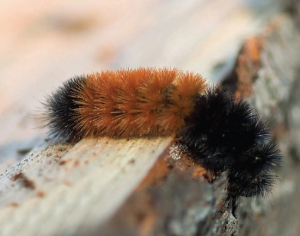 The wooly bear caterpillar is famous for being able to predict the weather, but it might just as well be for its gaudy clothes. Jet black at the ends with a large orange band in the middle, this is a caterpillar that doesn’t mind calling attention to itself. Later in life, when it becomes a tiger moth, it becomes drab and undistinguished. A bug among bugs. But when it is in the caterpillar form, you can’t help but notice.
The wooly bear caterpillar is famous for being able to predict the weather, but it might just as well be for its gaudy clothes. Jet black at the ends with a large orange band in the middle, this is a caterpillar that doesn’t mind calling attention to itself. Later in life, when it becomes a tiger moth, it becomes drab and undistinguished. A bug among bugs. But when it is in the caterpillar form, you can’t help but notice.
And, back in the past sometime, people noticed that the width of that band in the middle of the caterpillar’s body was a bit wider or narrower than it had been in seasons past. And folk wisdom accumulated around that fact until it was said—and, by some, believed—that the width of that band correlated with the severity of the coming winter. A wide band indicated that the winter would be mild. Narrow band? Better lay in some canned goods and extra firewood.
Is there any validity to this charming bit of folklore?
Well, back in the 50s a man with scientific training did some casual research over the course of a few years and his finding proved conclusively that … maybe, maybe not. Probably maybe not. Since then, the scientific consensus has come down on the side of maybe not.
Still, it is a nice theory and adds a bit of color to things. For years, the Farmer’s Almanac has been asking its readers to communicate their findings as to the width of the orange band on the caterpillars they come across and reminding— advising—them that If there is a narrow orange band in the middle of the Wooly Bear caterpillar, it warns of heavy snow. If they are fat and fuzzy expect bitter cold.
Lately, there has been some rudimentary research yielding evidence that the wooly bear might be able to tell you something about the severity of the winter. Last winter, that is. More of the brown/orange hair indicates that it has been through a long-lasting winter. But, since you had been through the same winter, you already knew that, didn’t you.
There is something else that sets the wooly bear up for human fascination, if not admiration. The caterpillars you see crossing the driveway on their way to some kind of shelter for the winter are about to go into the most extreme kind of hibernation. Their bodies actually become frozen. It takes a while for them to thaw and then make the change into moth form. So at the higher, Arctic end of its range, a wooly bear may have to go through this deep freeze technique several times before it gets to become a moth.
Tough life. But a great set of threads.
-Northshire Nature

